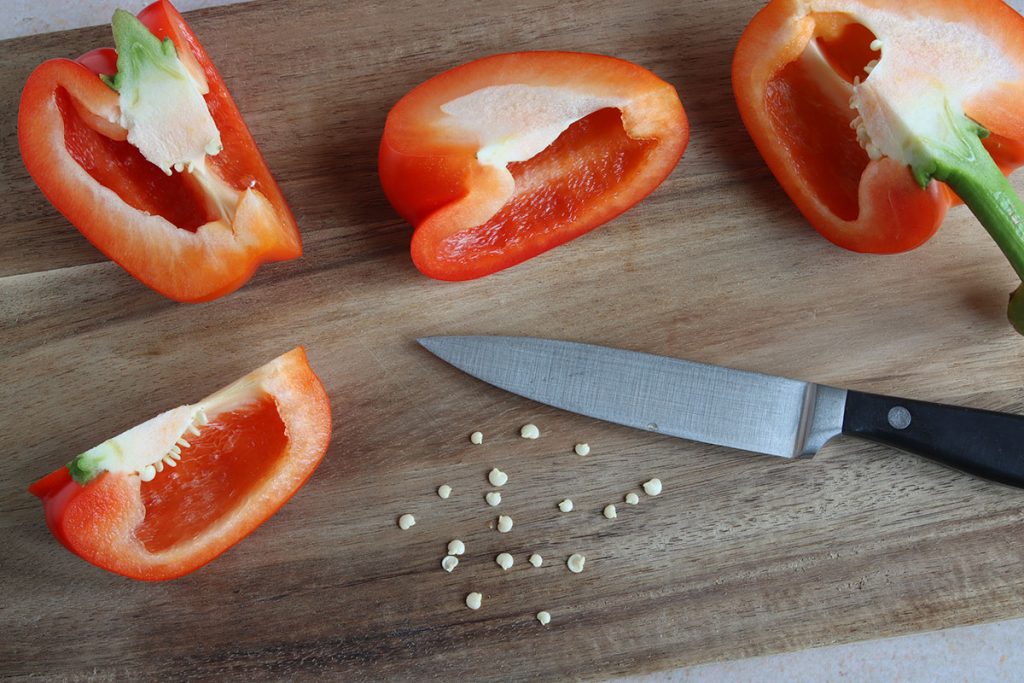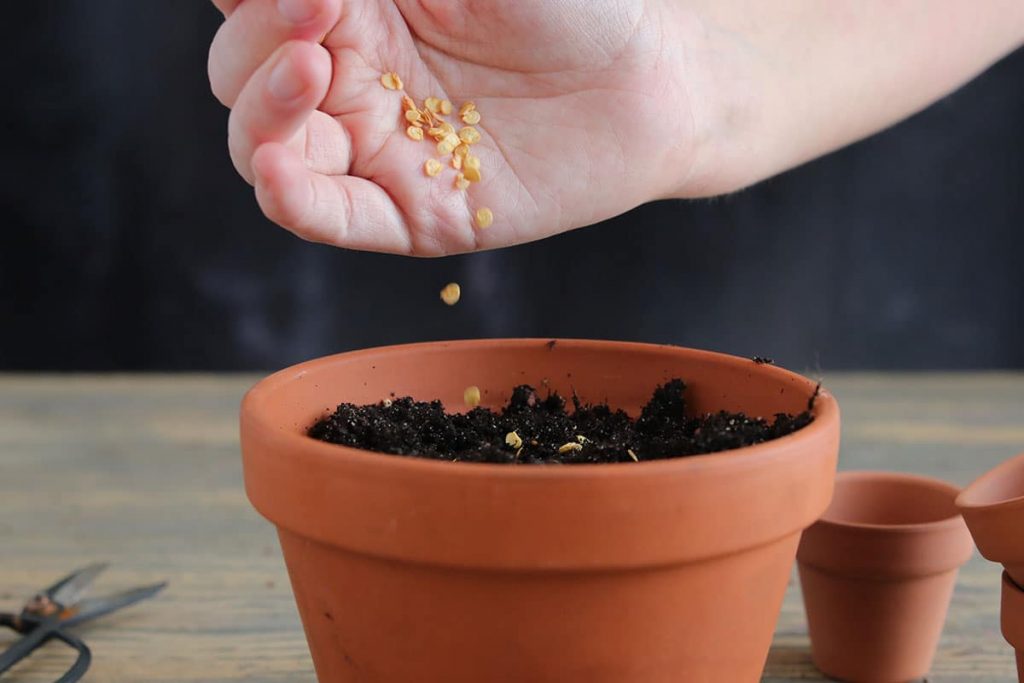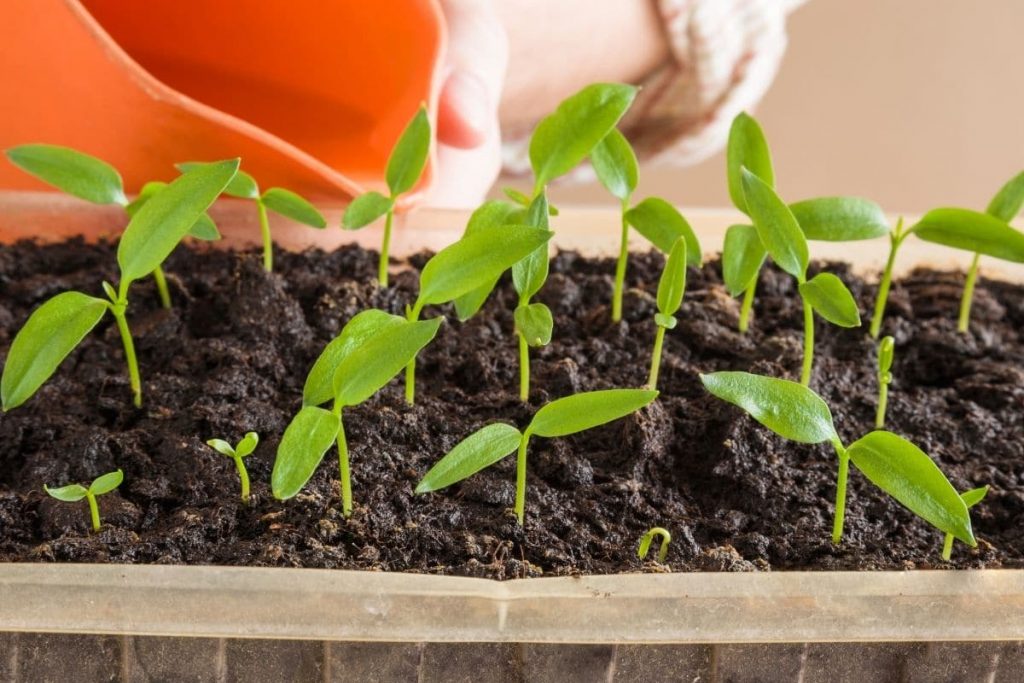Last updated on October 23rd, 2023 at 08:45 pm
A tasty bell pepper from the supermarket can be the basis for homegrown plants. Not every store-bought bell pepper has germinable seeds, and seasonal fruits in particular have a high germination rate.
- Peppers must be fully ripe for seed collection
- let bell bell pepper seeds dry for several days
- to be able to harvest early, sowing must be done already in February
- until planting in mid-May, the young plants need at least twelve hours of light
- before planting, the young plants must be hardened off
Contents
- 1 Seasonal & Organic Quality
- 2 Use of seeds from seasonal fruits increases chance of ripe peppers
- 3 Use aromatic fruits
- 4 Hybrid varieties
- 5 Hybrid breeding also has disadvantages
- 6 Sowing in late winter
- 7 Instructions for sowing
- 8 Separate
- 9 Planting out
- 10 Instructions for planting:
- 11 Tie young plant to a long support rod
- 12 Harvest
- 13 Frequently asked questions
- 14 Are there any methods to speed up germination?
- 15 Do I have to shorten the root when pricking out?
- 16 Can I also cultivate the plants in a pot?
- 17 Author
Seasonal & Organic Quality
A beautiful yellow or red bell bell pepper does not necessarily have germinable seeds. The bell pepper may change the color of its skin, but this does not change the degree of ripeness and germination of the seeds. This means that in the case of the bell bell pepper, the seeds of a red fruit do not necessarily have to be germinable.
It can never be said with certainty whether it is actually a ripe harvested bell pepper or an unripe fruit that has merely changed color.
Use of seeds from seasonal fruits increases chance of ripe peppers
- bell pepper season from July to October
- preferentially choose fruits in July, as chance of early harvest is very high
- Fruits from sustainable production offer even greater chance of germinating seeds
- Bell pepper fruits in organic quality or from regional markets good source for seeds

Tip: At regional markets, you can find not only peppers with seeds that can germinate, but often special varieties that are not offered in the supermarket.
Use aromatic fruits
Only remove seeds from a purchased bell pepper that tastes aromatic. This is also an indication of a fully mature bell pepper with seeds that can germinate. If the bell pepper has little flavor of its own or still tastes unripe, do not use those seeds.
- Seeds of immature fruits sometimes do not dry, but begin to mold after removal
- Seeds of unripe peppers simply turn brown and shrivel up
Therefore, never sow the seeds immediately after taking them out, but let them dry for about a week. If the seeds are still thick and whitish then, this is also an indication that the seeds are ready to germinate.
Tip: Before you sow the seeds, make a germination test. To do this, place the seeds in an airtight container with a damp paper towel and if none of the seeds germinate after three weeks, they are not germinable.
Hybrid varieties
A purchased bell pepper may be the result of hybrid breeding. These are not genetically modified organisms, as is often wrongly assumed, but seeds that are simply guaranteed to have the desired characteristics in the first generation of offspring. This is achieved by inbreeding over a period of several years, and it is only through renewed cross-fertilization that vigorous and vital fruits are produced again.
Hybrid breeding also has disadvantages
- from the second generation onwards characteristics are often less pronounced
- Yield/size can be significantly lower
- With a little luck, however, you will catch seed-proof peppers that can be propagated without any problems.
Sowing in late winter
In order for homegrown bell pepper plants to bear fruit, you need to start sowing seeds very early. Already germination of seeds can take up to two weeks. It can also take several months for the first flowers to form, and it also takes a long time for the fruit to ripen.
The ideal time for sowing is no later than February. However, to ensure that the plants have sufficient light until they are planted, it is imperative that you have a suitable planting lamp that provides full light for the plants for at least twelve hours a day. In this way, you will prevent the plants from wilting. If you have the appropriate infrastructure for the young plants, nothing stands in the way of sowing.

Instructions for sowing
- Fill the propagator with growing soil
- Spread seeds evenly with sufficient distance from each other
- Cover seeds with soil in double seed thickness
- Lightly press down the soil
- Water substrate
- Cover
You can speed up germination by placing the seeds in warm water for 24 hours and put the whole thing in a warm place.
Separate
Shortly after germination, you can already prick out the plants. Compared to tomatoes, bell pepper plants take much longer to form a first true pair of leaves, so you can separate them while they are still in the cotyledon stage.
Use a nutrient-rich soil as substrate, but it should not be too rich. Ideal is a mixture half with growing soil and half with vegetable soil. Alternatively, you can mix in perlite instead of the potting soil, which has the additional advantage that the soil remains looser and the granules store water, which they later release back into the environment.
Tip: When you separate the young plants into pots, make sure that they are initially watered only from below into saucers. This will reduce your risk of fusarium wilt, a fungal infection that causes young plants to simply fall over.
Planting out
As long as the peppers you grow from seed have adequate light, they can be in a warmer environment. By the time you plant them, they should be no longer than 30 centimeters and have a strong trunk. During the period, water only moderately, as this promotes the formation of roots.
From mid-May, you can plant the plants in the unheated greenhouse or open ground. Before you can put out the plants that you grow from seed, you still need to harden them. To do this, place the isolated seedlings outdoors in a shady spot about two weeks before the planned date for planting out.
This will allow the plant to form protective substances against UV radiation. About a week before the planting date, the plants can then already be placed in the sun.

Instructions for planting:
- Loosen the soil
- work organic slow release fertilizer into the soil
- dig a planting hole
- Insert the peppers and fill the planting hole with soil
- Press down the soil well
Tie young plant to a long support rod
High-yielding bell pepper plants usually need additional support because the plant or individual shoots can break under the load of the fruit. An alternative to the support rod for large-scale cultivation is a coarse-meshed plant trellis that is mounted horizontally at a height of about 30 – 40 cm. The plants grow through the grid and the meshes form a support for them.
Harvest
Whether a purchased bell pepper, from the seeds of which you grow new plants, will produce the same fruits in size and aroma, you can see from about July. However, taking seeds from a bell pepper and growing new plants from them is always an exciting experiment that quite often yields very aromatic fruit.
When you harvest the first ripe bell pepper, do not forget to take the seeds from it again. From the seeds they again grow new plants and thus no longer rely on purchased seeds. Since a purchased bell pepper is usually not identified with variety names, describe the fruit as accurately as possible, so that you also know which seeds they multiply.
You may not have much information about the purchased bell pepper at first. However, over the years you can gather more information such as when the fruit ripens or yield. After about two to three years, you will also find out whether it is a high-yielding and seed-resistant variety.
Frequently asked questions
Are there any methods to speed up germination?
Besides presoaking, there is also the possibility to rub the seeds with sand beforehand. This makes the seed coat thinner and the seedling can break through it more easily. However, this also increases the risk that the seedling will be killed prematurely by germs and bacteria.
Do I have to shorten the root when pricking out?
That depends on the root length. You should shorten very long roots that are bent off in the pot.
Can I also cultivate the plants in a pot?
Peppers are one of the few vegetables that grow very well in pots. The pot does not necessarily have to be very large, but you should provide the plants with organic nutrients on an ongoing basis. With the formation of fruit, you can fertilize a little potash emphasized.


